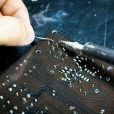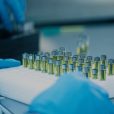A semiconductor company with a quantum computing and medical diagnostics focus, Archer Materials Limited (ASX: AXE), has announced a notable development in its advanced Biochip graphene field effect transistor (gFET) technology.
Archer has successfully demonstrated multiplexing readout capabilities for its Biochip, i.e. they have shown the device can make sense of multiple liquid samples arriving at the sensors of the chip in order to allow the potential detection of numerous diseases in one go, saving time and money.
Archer integrated four advanced gFETs as sensors into its Biochip platform, enabling single-device multiplexing. This breakthrough paves the way for simultaneous testing of multiple diseases on a single chip, a challenging feat that is made possible thanks to the single atom thick material called graphene.
CEO of Archer, Dr. Mohammad Choucair, commented, “Archer is now able to demonstrate readout, or a signal, from multiple graphene sensors and liquid samples coming from the Biochip, which is a step-change in advancing towards the potential to sense multiple disease samples at once on a single chip.
“The progress made by the Archer team to demonstrate multiplex detection, and the support of our commercial foundry partners in the manufacture of Archer’s Biochip devices, will be applied towards the function and operation of the Biochip in targeting biologically relevant molecules.”
Archer’s biochip innovation aims to integrate gFETs into advanced fluidic systems, creating miniaturised lab-on-a-chip platforms for medical diagnostics. It could transforms disease detection, which otherwise boasts a high emotional and financial cost.
One of the key advancements for Archer’s biochip is the new hardware and software systems they have designed and developed to read out signals from the gFET sensors simultaneously, marking a major improvement over the previous generation of the Biochip system, which could only activate one sensor at a time.
Moreover, the new Biochip system features automated hands-free operation, integrating liquid handling automation and data acquisition. Archer states its “software offers real-time display of single and time-series measurements for all four gFET sensors simultaneously”.
Dr. Choucair noted, “Moving testing for diseases from the lab onto a chip has the potential to create better access to healthcare for those who might not have it, thereby improving patient outcomes.”
In addition to its Biochip endeavours, Archer Materials is making progress with its 12CQ (pronounced one-two-cee-que) quantum chip technology, particularly in the design and validation of qubit control and readout technology and associated engineering processes and measurements required for quantum chip operation and function. These developments are aimed at making quantum computing more accessible in everyday devices.
Furthermore, Archer is strengthening its relationships with global semiconductor foundry partners to deliver its chips using a streamlined ‘fabless’ commercialisation model. During Q1 FY24, Archer engaged with several tier-one foundry manufacturers in Taiwan and Europe to secure future semiconductor product manufacturing capabilities and support technology development.
This “included obtaining device design kits and planning for preliminary device design validations for quantum and biochip technologies, including multi-project wafers (MPW) and whole wafer runs.”
As of the end of the quarter, Archer Materials reported $21.3 million in cash, with a cash burn of just $1.9 million, primarily driven by its technology development efforts and staff costs. As it addresses health and tech inequity, Archer is poised for growth.
- Ovanti’s iSentric signs contracts worth $14.4m with Malaysian commercial bank - June 27, 2024
- Baby Bunting fights back from retail downturn with 5-year strategy, includes Gen-Z focus and self-funded growth - June 27, 2024
- CLEO meets with US FDA to develop strategy for ovarian cancer test launch - June 26, 2024













Leave a Comment
You must be logged in to post a comment.